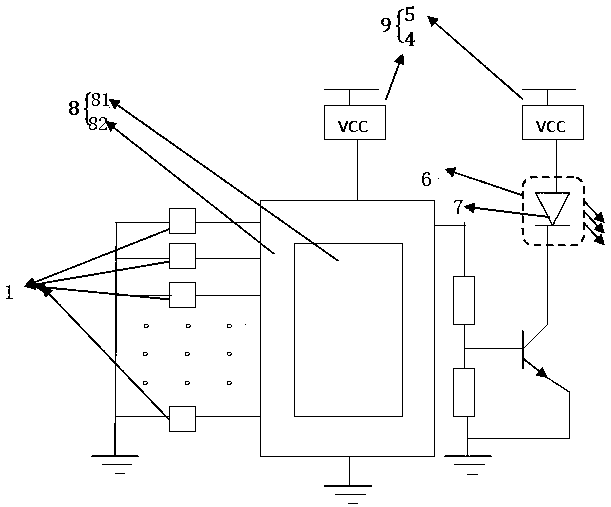A new type of photoelectric musical instrument
A technology for optoelectronics and musical instruments, applied in the field of speakers, can solve the problems of low photoacoustic conversion efficiency, low irradiance, single optical frequency, etc., and achieve the effects of high photoacoustic conversion efficiency, prolonged service life, and good listening experience.
- Summary
- Abstract
- Description
- Claims
- Application Information
AI Technical Summary
Problems solved by technology
Method used
Image
Examples
Embodiment 1
[0032] The structure diagram of a new type of photoelectric musical instrument in this embodiment is as Figures 1 to 3 As shown, it includes a power supply module 9, a control module 8, a light source 7, a sound module 6 and several scale volume input modules 1; the power supply module 9 is used to supply power to the control module 8 and the light source 7; the light source 7 and the sound The number of modules 6 is several, and the sound module 6 is used to convert the light emitted by the light source 7 into sound; the light source 7 and each scale volume input module 1 are respectively connected with the control module 8; trigger a scale volume input module 1 , the corresponding light source 7 emits light with a certain flicker frequency, and the sound module 6 converts the light emitted by the light source 7 into sound.
[0033]In this embodiment, the control module 8 includes a main control chip 81 and peripheral circuits 82 . A program is written in the main control c...
Embodiment 2
[0042] The difference between this embodiment and Embodiment 1 is that the size of the sound module 6 cavity is different. In this embodiment, the scale volume input module 1 has the same number as the sound module 6; different sizes can be customized according to the flicker frequency of the light source 7 The sound module 6, such as Figure 4 shown. With this setting, each semi-closed cavity can resonate with the corresponding scale, so as to emit a larger volume, so that people can have a better listening experience. When the control module 8 receives the signal input by the scale input button, it only needs to output a control command to the light source 7 in the corresponding sound module 6, so as to reduce the number of working light sources and save energy.
Embodiment 3
[0044] The difference between this embodiment and Embodiment 1 and Embodiment 2 is that the volume control method is different and the control module 8 is different. In this embodiment, the control module 8 also includes an AD conversion module 83, and the AD conversion module 83 Used to convert analog signals into electrical signals, such as Figure 6 As shown; the scale volume input module 1 includes a scale input button and a volume control button; the scale input button is provided with a pressure sensor 11, and the pressure sensor 11 is connected to the control module 8; the volume control button is a piano pedal structure. Such as Figure 7 As shown, it is a structural schematic diagram of the scale input button in this embodiment, including a cover plate 13, a scale button 12 and a pressure sensor 11, and the scale button 12 and the pressure sensor 11 are all located under the cover plate 13; Figure 8 As shown, it is a structural diagram of the volume input button in ...
PUM
 Login to View More
Login to View More Abstract
Description
Claims
Application Information
 Login to View More
Login to View More - R&D
- Intellectual Property
- Life Sciences
- Materials
- Tech Scout
- Unparalleled Data Quality
- Higher Quality Content
- 60% Fewer Hallucinations
Browse by: Latest US Patents, China's latest patents, Technical Efficacy Thesaurus, Application Domain, Technology Topic, Popular Technical Reports.
© 2025 PatSnap. All rights reserved.Legal|Privacy policy|Modern Slavery Act Transparency Statement|Sitemap|About US| Contact US: help@patsnap.com



